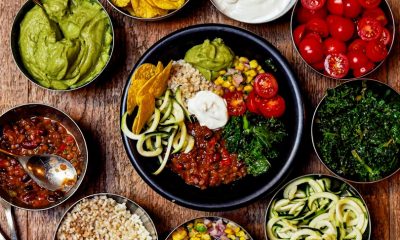NewsMakers
Serving larger portions of veggies may increase young kids’ veggie consumption
The researchers found that while the larger portions of vegetables were associated with greater intake, the addition of butter and salt was not. The children also reported liking both versions — seasoned and unseasoned — about the same. About 76% of kids rated the vegetables as “yummy” or “just ok.”

It can be difficult to get young kids to eat enough vegetables, but a new Penn State study found that simply adding more veggies to their plates resulted in children consuming more vegetables at the meal.
The researchers found that when they doubled the amount of corn and broccoli served at a meal — from 60 to 120 grams — the children ate 68% more of the veggies, or an additional 21 grams. Seasoning the vegetables with butter and salt, however, did not affect consumption.
The daily recommended amount of vegetables for kids is about 1.5 cups a day, according to the official Dietary Guidelines for Americans as set by the U.S. Departments of Agriculture and Health and Human Services.
“The increase we observed is equal to about one third of a serving or 12% of the daily recommended intake for young children,” said Hanim Diktas, graduate student in nutritional sciences. “Using this strategy may be useful to parents, caregivers and teachers who are trying to encourage kids to eat the recommended amount of vegetables throughout the day.”
Barbara Rolls, Helen A. Guthrie Chair and director of the Laboratory for the Study of Human Ingestive Behavior at Penn State, said the findings — recently published in the journal Appetite — support the MyPlate guidance from the U.S. Department of Agriculture, which recommends meals high in fruits and vegetables.
“It’s important to serve your kids a lot of vegetables, but it’s also important to serve them ones they like because they have to compete with the other foods on the plate,” Rolls said. “Parents can ease into this by gradually exposing kids to new vegetables, cooking them in a way their child enjoys, and experimenting with different flavors and seasonings as you familiarize them.”
According to the researchers, the majority of children in the U.S. don’t eat the recommended daily amount of vegetables, which could possibly be explained by children having a low preference for them. And while serving larger portions has been found to increase the amount of food children eat — called the “portion size effect” — kids tend to eat smaller amounts of vegetables in response to bigger portions compared to other foods.
For this study, the researchers were curious if increasing just the amount of vegetables while keeping the portions of other foods the same would help increase veggie consumption in kids. They also wanted to experiment with whether adding light butter and salt to the vegetables would increase their palatability and also affect consumption.
For the study, the researchers recruited 67 children between the ages of three and five. Once a week for four weeks, the participants were served lunch with one of four different preparations of vegetables: a regular-sized serving of plain corn and broccoli, a regular-sized serving with added butter and salt, a doubled serving of plain corn and broccoli, and a doubled serving with added butter and salt.
During each meal, the vegetables were served alongside fish sticks, rice, applesauce and milk. Foods were weighed before and after the meal to measure consumption.
“We chose foods that were generally well-liked but also not the kids’ favorite foods,” Rolls said. “If you offer vegetables alongside, say, chicken nuggets you might be disappointed. Food pairings are something you need to be conscious of, because how palpable the vegetables are compared to the other foods on the plate is going to affect the response to portion size. You need to make sure your vegetables taste pretty good compared to the other foods.”
After analyzing the results, the researchers found that while the larger portions of vegetables were associated with greater intake, the addition of butter and salt was not. The children also reported liking both versions — seasoned and unseasoned — about the same. About 76% of kids rated the vegetables as “yummy” or “just ok.”
“We were surprised that the butter and salt weren’t needed to improve intake, but the vegetables we served were corn and broccoli, which may have been already familiar to and well-liked by the kids,” Diktas said. “So for less familiar vegetables, it’s possible some extra flavoring might help to increase intake.”
Diktas said that while serving larger portions may increase vegetable consumption, it also has the potential to increase waste if kids don’t eat all of the food that is served.
“We’re working on additional research that looks into substituting vegetables for other food instead of just adding more vegetables,” Diktas said. “In the future, we may be able to give recommendations about portion size and substituting vegetables for other foods, so we can both limit waste and promote veggie intake in children.”
Liane Roe, research nutritionist; Kathleen Keller, associate professor of nutritional sciences; and Christine Sanchez, lab manager at the Laboratory for the Study of Human Ingestive Behavior, also participated in this work.
NewsMakers
Millennials and Gen Zs prioritize health, purpose, financial independence, but health and wellness gaps persist
Younger Filipinos are placing greater emphasis on healthspan, purpose, and financial independence. However, the study also revealed that while 83% of young respondents have good knowledge about health and wellness, only 76% say they are taking sufficient action to consistently practice healthy habits.

While millennials and Gen Zs in the Philippines are reshaping what it means to live well and live long, significant gaps between awareness and action jeopardize their health, wellness, and longevity aspirations, a new study by Manulife Philippines has found.
According to “#FYP: Future-proofing Young Pinoys: Examining Health and Longevity Perspectives, Sentiments, and Aspirations of Millennials and Gen Zs,” which was conducted among 500 respondents across the Philippines, younger Filipinos are placing greater emphasis on healthspan, purpose, and financial independence. However, the study also revealed that while 83% of young respondents have good knowledge about health and wellness, only 76% say they are taking sufficient action to consistently practice healthy habits.
“With a median age of 26.1, the Philippines has one of the youngest populations in Asia. Our latest study highlights the need to support younger generations in translating their health, wellness, and longevity aspirations into meaningful action. We found that millennials and Gen Zs are motivated to live healthier lives, but barriers like stress, excessive screen time, and sleep deprivation, among many others are holding them back from achieving this goal,” said Rahul Hora, President and Chief Executive Officer, Manulife Philippines.
Motivated to be healthy, but stress gets in the way; Millennial women among the most affected
The study found that millennials and Gen Zs are not short of motivation to pursue their health and wellness goals. While 64% said they are pursuing health to avoid getting sick, and 44% said they want to minimize potential medical expenses, many are equally driven by their personal well-being and self-image about feeling and looking good: 44% said they want to look good or fit, and 43% said they want to look youthful.
Younger Filipinos, especially women, are also putting more focus on healthspan, or the number of the years we live healthily, over lifespan. According to the survey, 60% of female respondents prefer to prolong their healthspans, while 53% of males prefer to prolong their lifespans.
Filipino millennials and Gen Zs face notable health and wellness gaps, from monitoring to their actual wellness behaviors:
- Young Filipinos show significant gaps in health monitoring (awareness vs what they actually monitor), particularly in mobility (24%), nutrition (23%), and cholesterol levels (20%). Gender differences are evident, with young women struggling more with nutritional monitoring (27%) and young men facing greater challenges in mobility monitoring (28%).
- Many young Filipinos find it difficult to consistently maintain healthy sleeping habits (20%), achieve work-life balance (19%), and follow a balanced diet (15%). Women report a larger gap in achieving work-life balance at 22%, compared to the 15% gap among men.
- Stress is the most prominent barrier to wellness, affecting 64% of respondents. Millennials report higher stress levels than Gen Zs (69% vs. 58%), and women are more affected than men (73% vs. 55%). Notably, 76% of millennial women say stress prevents them from pursuing their desired wellbeing—the highest among all generational and gender groups.
- Modern lifestyle habits further compound these issues, with excessive screen time impacting 48% and sleep deprivation affecting 45% of young Filipinos. Trends such as “bedrotting” and “doomscrolling” reflect how contemporary behaviors are undermining their wellness goals.
“We’re seeing that for young Filipinos, intent alone isn’t sufficient. While many are motivated to pursue healthier lives, they’re facing a complex mix of stressors and lifestyle gaps, which make it difficult to follow through. These habits quietly derail their ability to prioritize wellness. That’s why the next step is to find ways to embed wellness into their daily routine. By offering health and wellness-focused programs and collaborations with likeminded partners, we are helping them bridge the gap between intention and action, turning wellness goals into sustainable, everyday behaviors supporting their long-term health and longevity aspirations,” added Hora.
Younger Filipinos view age positively and prioritize attaining purpose and living independently than being illness-free
According to the study, 96% of millennials and Gen Zs surveyed believe aging is a natural process that should be embraced with positivity, while 91% of the respondents believe that living a meaningful life is more important than living a long one. The study revealed a striking perspective on aging priorities, with 83% of respondents believing that living independently and being able to do things that matter most to them is more important than being illness-free.
Millennials surveyed focus more on physical health and family relationships as they age. Gen Zs, on the other hand, lean toward self-discovery, purpose, and making an impact. Only 13% of both generations consider maximizing lifespan as a top priority, with men showing slightly higher interest (17%) compared to women (8%).
“The findings reveal that young Filipinos see aging not as decline, but as a chance to live with purpose and independence,” Hora said. “It is therefore crucial that we create opportunities and support systems for them to live better at every stage of their lives. This means investing in holistic wellness programs, accessible financial health education, as well as tools that address both physical and mental needs, tailored especially for younger generations navigating various stressors of the modern world.”
“As one of the country’s longest-serving insurers, Manulife Philippines is deeply committed to supporting younger generations of Filipinos in their journey toward financial independence and longevity. Through our innovative insurance and investment solutions, and our nationwide network of over 10,000 professional financial advisors, we aim to empower millennials and Gen Zs to live fuller, healthier lives with purpose and confidence as they age,” said Hora.
Financial independence: Younger Filipinos’ ultimate longevity concern
When it comes to living a longer life but also “adding life to years,” financial security tops the list of concerns for both generations. Among the respondents, 74% believe that longevity is a blessing only if they have sufficient financial resources, with running out of money being their greatest worry (61%). Millennials and Gen Zs agree that mental health is a top longevity concern (36% and 47%, respectively). Millennials surveyed are more concerned about keeping ties with children (37%), while Gen Zs are more concerned about living their desired lifestyle (39%).
Gaining financial independence is also a top longevity priority for young Filipinos (52%), followed by family relationships (36%) and physical health (33%). Women, however, prioritize financial independence significantly more than men (60% vs. 44%). This gender gap reflects broader structural realities women face in the Philippines. Despite having longer life expectancies (69.9 vs 63.4), women have lower labor force participation (52.9% vs 76.3%) and are prone to career interruptions due to family and caregiving responsibilities. These factors make financial independence especially urgent for women, who must plan for longer retirement years with potentially fewer financial opportunities.
Financial planning remains one of the many challenges the youth face. Gen Zs surveyed estimate needing PHP22.3 million to achieve financial independence upon retirement, while millennials estimate PHP18.4 million. Yet only 20% of respondents have very high confidence in achieving these goals. Despite the challenges, young Filipinos take proactive steps. Among those who prioritize financial independence, 65% save part of their income, 45% purchase insurance, and 43% actively broaden their financial knowledge. However, 68% admit that sustaining investments remains difficult.
“It’s encouraging to see today’s younger generations starting to take more proactive steps toward financial planning. We’re seeing a shift in mindset, where millennials and Gen Zs are actively saving, purchasing insurance, and expanding their financial literacy. These are promising signs,” said Aira Gaspar, President and Chief Executive Officer, Manulife Investments Philippines.
“The key now is to help them bridge the gap between intention and sustained action, through accessible, flexible investment strategies that evolve with their life stages, financial capabilities, and aspirations. By enabling them with the right tools and guidance, we can help turn financial independence into a tangible, achievable reality for our younger customers in the Philippines,” added Gaspar.
NewsMakers
Drinking any amount of alcohol likely increases dementia risk
Even light drinking—generally thought to be protective, based on observational studies—is unlikely to lower the risk, which rises in tandem with the quantity of alcohol consumed.

Drinking any amount of alcohol likely increases the risk of dementia, suggests the largest combined observational and genetic study to date, published online in BMJ Evidence Based Medicine.
Even light drinking—generally thought to be protective, based on observational studies—is unlikely to lower the risk, which rises in tandem with the quantity of alcohol consumed, the research indicates.
Current thinking suggests that there might be an ‘optimal dose’ of alcohol for brain health, but most of these studies have focused on older people and/or didn’t differentiate between former and lifelong non-drinkers, complicating efforts to infer causality, note the researchers.
To try and circumnavigate these issues and strengthen the evidence base, the researchers drew on observational data and genetic methods (Mendelian randomisation) from two large biological databanks for the entire ‘dose’ range of alcohol consumption.
These were the US Million Veteran Program (MVP), which includes people of European, African, and Latin American ancestry, and the UK Biobank (UKB), which includes people of predominantly European ancestry.
Participants who were aged 56–72 at baseline, were monitored from recruitment until their first dementia diagnosis, death, or the date of last follow-up (December 2019 for MVP and January 2022 for UKB), whichever came first. The average monitoring period was 4 years for the US group, and 12 for the UK group.
Alcohol consumption was derived from questionnaire responses—over 90% of participants said they drank alcohol—and the Alcohol Use Disorders Identification Test (AUDIT-C) clinical screening tool. This screens for hazardous drinking patterns, including the frequency of binge drinking (6 or more drinks at a time).
In all, 559,559 participants from both groups were included in observational analyses, 14,540 of whom developed dementia of any type during the monitoring period:10,564 in the US group; and 3976 in the UK group. And 48,034 died: 28,738 in the US group and 19,296 in the UK group.
Observational analyses revealed U-shaped associations between alcohol and dementia risk: compared with light drinkers (fewer than 7 drinks a week) a 41% higher risk was observed among non-drinkers and heavy drinkers consuming 40 or more drinks a week, rising to a 51% higher risk among those who were alcohol dependent.
Mendelian randomisation genetic analyses drew on key data from multiple large individual genome-wide association studies (GWAS) of dementia, involving a total of 2.4 million participants to ascertain lifetime (rather than current) genetically predicted risks.
Mendelian randomisation leverages genetic data, minimising the impact of other potentially influential factors, to estimate causal effects: genomic risk for a trait (in this case, alcohol consumption) essentially stands in for the trait itself.
Three genetic measures related to alcohol use were used as different exposures, to study the impact on dementia risk of alcohol quantity, as well as problematic and dependent drinking.
These exposures were: self-reported weekly drinks (641 independent genetic variants); problematic ‘risky’ drinking (80 genetic variants); and alcohol dependency (66 genetic variants).
Higher genetic risk for all 3 exposure levels was associated with an increased risk of dementia, with a linear increase in dementia risk the higher the alcohol consumption.
For example, an extra 1-3 drinks a week was associated with a 15% higher risk. And a doubling in the genetic risk of alcohol dependency was associated with a 16% increase in dementia risk.
But no U-shaped association was found between alcohol intake and dementia, and no protective effects of low levels of alcohol intake were observed. Instead, dementia risk steadily increased with more genetically predicted drinking.
What’s more, those who went on to develop dementia typically drank less over time in the years preceding their diagnosis, suggesting that reverse causation—whereby early cognitive decline leads to reduced alcohol consumption—underlies the supposed protective effects of alcohol found in previous observational studies, say the researchers.
They acknowledge that a principal limitation of their findings is that the strongest statistical associations were found in people of European ancestry, because of the numbers of participants of this ethnic heritage studied. Mendelian randomisation also relies on assumptions that can’t be verified, they add.
Nevertheless, they suggest that their findings “challenge the notion that low levels of alcohol are neuroprotective.”
And they conclude: “Our study findings support a detrimental effect of all types of alcohol consumption on dementia risk, with no evidence supporting the previously suggested protective effect of moderate drinking.
“The pattern of reduced alcohol use before dementia diagnosis observed in our study underscores the complexity of inferring causality from observational data, especially in ageing populations.
“Our findings highlight the importance of considering reverse causation and residual confounding in studies of alcohol and dementia, and they suggest that reducing alcohol consumption may be an important strategy for dementia prevention.”
NewsMakers
Distribution of fat could influence cancer risk, study suggests
Obesity is usually measured using body mass index (BMI), but growing evidence – particularly from heart health research – suggests that BMI alone doesn’t capture the full picture when it comes to obesity-related health risks. However, the role of fat distribution in cancer risk has been relatively unexplored.

How fat is distributed in people’s bodies could make a difference to their risk of certain cancers, according to new research led by the University of Bristol. The international study is published in the Journal of the National Cancer Institute (JNCI).
Scientists have already shown that having obesity increases a person’s risk of developing certain cancers. Obesity is usually measured using body mass index (BMI), but growing evidence – particularly from heart health research – suggests that BMI alone doesn’t capture the full picture when it comes to obesity-related health risks. However, the role of fat distribution in cancer risk has been relatively unexplored.
Researchers in Bristol’s Integrative Cancer Epidemiology Programme (ICEP) investigated whether body fat at different locations across the body influences the risks of 12 obesity-related cancers – endometrial, ovarian, breast, colorectal, pancreas, multiple myeloma, liver, kidney (renal cell), thyroid, gallbladder, oesophageal adenocarcinoma, and meningioma.
They used a technique known as Mendelian randomisation, which uses statistics, computing and the natural variations in people’s genetics to identify patterns in large health data sets.
The team found that fat distribution appears to influence cancer risk – but the relationship varies by cancer type. For some cancers, where fat is stored in the body seems more important than how much is stored; for others, the reverse is true; and, for some, both matter. In cancers where distribution is important, the specific locations of body fat driving this seem to differ by cancer, meaning the overall picture is quite complex.
Lead author, Dr Emma Hazelwood, who recently completed her PhD at the University of Bristol, explained: “These findings support the growing consensus that BMI, while useful for population-level trends, may be too simplistic for assessing individual health risks.
“Our results tell us that there is no ‘one-size-fits-all’ when it comes to cancer, meaning a more tailored approach to cancer prevention in people with obesity could be most effective.”
The paper’s findings fit with recent calls for change, including the 2024 European Association for the Study of Obesity framework and the Lancet Commission on the future of obesity, which have emphasised that BMI is a flawed diagnostic tool and that fat distribution matters.
In the future, a better understanding of how fat distribution across the body affects cancer risk could help identify those most at risk and guide more personalised approaches to obesity treatment and cancer prevention.
The research team recommend further work is needed, using different approaches and studying non-European populations.
Dr Hazelwood added: “It is vital to understand the biological mechanisms that underpin these associations – particularly how and why different fat depots affect cancer development. In the longer term, we need to explore how obesity treatments – whether lifestyle or drug-based – influence these risk pathways.”
Dr Julia Panina, Head of Research Funding at World Cancer Research Fund, added: “Our evidence-based Cancer Prevention Recommendations highlight the role of maintaining a healthy weight to reduce cancer risk. While this remains essential, growing scientific evidence shows that body composition – particularly how fat is distributed throughout the body – is also a crucial factor.
“With support from our fantastic donors, we were able to co-fund the University of Bristol’s excellent team whose findings will help direct this exciting area towards possible new cancer prevention and treatments.”
This study was funded by the World Cancer Research Fund (WCRF UK) and Cancer Research UK (Integrative Cancer Epidemiology Programme). This work was carried out at the MRC Integrative Epidemiology Unit (MRC IEU), which is supported by the Medical Research Council (MRC) and the University of Bristol.
-

 Product Showcase3 weeks ago
Product Showcase3 weeks agoManulife Philippines ‘Time to MOVE’ symposium focuses on health and longevity
-

 NewsMakers1 week ago
NewsMakers1 week agoMillennials and Gen Zs prioritize health, purpose, financial independence, but health and wellness gaps persist
-

 Product Showcase1 week ago
Product Showcase1 week agoAIA Philippines CEO named Executive Champion of the Year in Asia
-

 Travel4 weeks ago
Travel4 weeks agoSteak-hunting in Bulacan? We ended up in Project Steak
-

 Destinations2 weeks ago
Destinations2 weeks agoChecking religious expression at Montemaria in Batangas
-

 Product Showcase1 week ago
Product Showcase1 week agoKorean brand Wells showcases 23 years of engineering innovation
-

 Destinations3 weeks ago
Destinations3 weeks agoBeach-hunting led to Malabrigo Beach
-

 Product Showcase3 days ago
Product Showcase3 days agoManulife brings personalized gut health insights to PH










